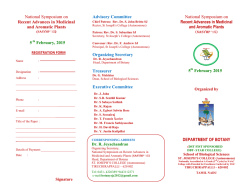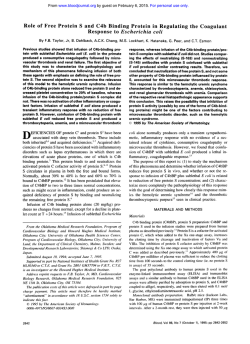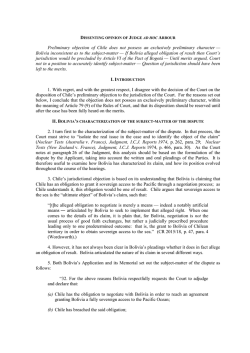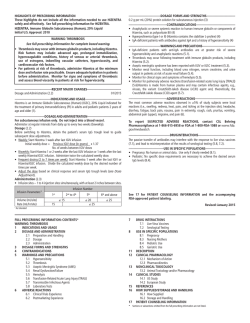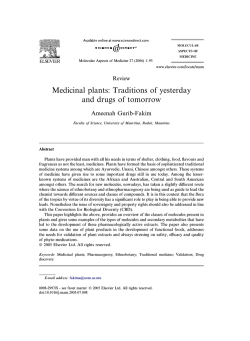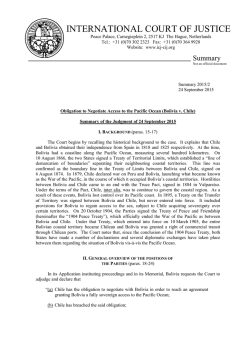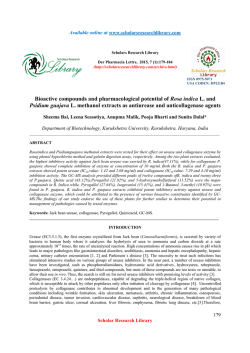
Ethnobotanical inventory of medicinal plants used in the
© 2017 Boletín Latinoamericano y del Caribe de Plantas Medicinales y Aromáticas 16 (1): 68 - 77 ISSN 0717 7917 www.blacpma.usach.cl Artículo Original | Original Article Ethnobotanical inventory of medicinal plants used in the Qampaya District, Bolivia [Inventario etnobotánico de plantas medicinales usadas en el Distrito Qampaya, Bolivia] Victor Cussy-Poma1, Eloy Fernández2, Johana Rondevaldova2, Hana Foffová2 & Daniela Russo3 1 2 Carrera de Ingeniería Agronómica, Universidad Nacional Siglo XX, Llallagua, Potosí, Bolivia. Department of Crop Sciences and Agroforestry, Faculty of Tropical AgroSciences, Czech University of Life Sciences Prague, Kamycka 129, Suchdol, 165 21 Prague 6, Czech Republic 3 Department of Science, University of Basilicata, v.le Ateneo Lucano, 85100 Potenza, Italy. . Contactos | Contacts: Eloy FERNÁNDEZ - E-mail address: [email protected] Abstract: Herbal medicine therapy is traditionally practiced by indigenous healers in Bolivia for hundreds years. Due to the great geographical and ecological diversity, there are thousands of native plants, which are utilized against diverse types of diseases. Nowadays, there is a worldwide problem connected with possible loss of ethnobotany knowledge because of the lack of the interest of young people. In present study, survey focused on medicinal plants used by rural people in Qampaya District, Potosí Department, Bolivia has been done. The data were collected from 60 respondents by semi-structured interviews. The results showed that 60 plant species belonging to 30 families are known as curative plants in this area. The mostly named families were Asteraceae (14 species) followed by Lamiaceae (7 species) and Brassicaceae (4 species). Predominant health problems treated by these plants are urological problems and gastro-intestinal disorders. The most frequently used plant parts were leaves and the preparation is mostly done as infusion. Even though the knowledge of using medical plants plays important role in life of Bolivian rural people, which use plants as medicines against various types of diseases, this study showed that 25% of respondents didn’t know any medicinal plants. On the other hand 40% of asked people have known 6 or more medicinal plant species. Keywords: Chenopodium ambrosioides, Ethnobotanical survey, Matricaria chamomilla, Mentha piperita, Nicotiana glauca, Potosí Department Resumen: La terapia de la medicina herbolaria es practicada, tradicionalmente, por los curanderos indígenas en Bolivia, desde hace cientos de años. Gracias a la gran diversidad geográfica y ecológica, hay miles de plantas nativas, que se utilizan para el tratamiento de diferentes tipos de enfermedades. Hoy en día, hay un problema mundial relacionado con la posible pérdida del conocimiento etnobotánico, esto debido a la falta de interés de las nuevas generaciones. El presente estudio descriptivo, mediante una encuesta, fue enfocado a las plantas medicinales utilizadas por la población rural del Distrito Qampaya, Departamento de Potosí, Bolivia. Los datos se obtuvieron de 60 informantes mediante una encuesta semiestructurada. Los resultados mostraron que 60 especies de plantas medicinales. pertenecientes a 30 familias botánicas, son conocidas en el área de intervención. Las familias botánicas, más importantes de uso medicinal son Asteraceae (14 especies), seguido de Lamiaceae (7 especies) y Brassicaceae (4 especies). Los problemas predominantes de salud, tratados con estas especies, son los urológicos y trastornos gastrointestinales. La parte de la planta más utilizada son las hojas y la forma más común de uso es en infusión. A pesar de que el conocimiento sobre la utilización de las plantas medicinales, juega un papel importante en la vida de la población rural de Bolivia, quienes utilizan las plantas medicinales para el tratamiento de diversos tipos de enfermedades, este estudio mostró que el 25% de los encuestados no tienen conocimiento sobre la utilidad medicinal de ninguna especie vegetal. Por otro lado, el 40% de los informantes conocen 6 o más especies de plantas medicinales. Palabras clave: Chenopodium ambrosioides, Estudio etnobotánico, Matricaria chamomilla, Mentha piperita, Nicotiana glauca, Departamento de Potosí Recibido | Received: September 17, 2015 Aceptado | Accepted: May 31, 2016 Aceptado en versión corregida | Accepted in revised form: August 16, 2016 Publicado en línea | Published online: January 31, 2017 Declaración de intereses | Declaration of interests: To Project N° 20165007 of University Internal Grant Agency, Czech University of Life Sciences Prague. Este artículo puede ser citado como / This article must be cited as: V Cussy-Poma, E Fernández, J Rondevaldova, H Foffová, D Russo. 2017. Ethnobotanical inventory of medicinal plants used in the Qampaya District, Bolivia. Bol Latinoam Caribe Plant Med Aromat 16 (1): 68 – 77. 68 Cussy-Poma et al. Ethnobotanical inventory of medicinal plant in Bolivia INTRODUCTION Ethnobotany is defined as the study of the relationships between peoples and plants. In general, it is a scientific investigation of the indigenous knowledge about plants that is unique to the culture or society (Diksha & Amla, 2011). This knowledge is traditionally passed orally from generation to generation and it has high value not only for the indigenous cultures in which occurs, but also for the scientific world. However, nowadays traditional knowledge is very often lost due to the lack of interest by young people, and thus the ethnobotanical documentation has a great importance for the conservation and utilization of biological resources (Muthu et al. 2006). Plants are used in different ways, mostly as a food and fodder, medicines, fuel, dying agents, construction and tool materials, as well as for rituals purposes (Ugulu & Aydin, 2011). As medicines, they are utilized for thousands of years, mostly by the traditional healers and shamans as treatment against many diseases. According to the World Health Organization around 65% of people in the world and up to 90% of the population in developing countries rely on traditional medicine for primary healthcare (Vandebroek et al., 2008). Medicinal plants also serve as a big source of secondary metabolites which are valuable for pharmaceutical industry and drug discovery. In developed countries, 25% of drugs are based on plants and their derivatives (Bodeker & Burford, 2007). Moreover in recent time, people from developed countries increased their interest on drugs of plant origin as alternative therapies, because conventional medicine is often ineffective and use of synthetic drugs can caused many side effects and other problems (Rates, 2001). Bolivia is land locked country in the tropical zone, with big differences in climatic conditions which together with dramatic variations in topography resulted in a wide range of ecosystems with extreme plant biodiversity. The geography of Bolivia includes three main zones: Altiplano and Andes, the Gran Chaco, and the Amazon Rainforest. Bolivian population is about 10 million from which more than 60% are native Bolivians belonging to 36 ethnic groups. The largest groups are predominantly indigenous Quechua, into which traditional healers Kallawaya belong, and Aymara people. Main language is Quechua, spoken by 86%, while 74% of the population speaks Spanish. Their traditional agricultural system is focused on potatoes (Solanum tuberosum L.), oca (Oxalis tuberosa Molina), goosefoot (Chenopodium quinoa Willd), maize (Zea mays L.) and isaño (Tropaeolum tuberosum Ruiz & Pav.). They breed cattle (Bos), sheep (Ovis), alpacas (Lama guanicoe), llamas (Lama glama) (De Lucca & Zalles, 1992). This is the typical way of life in the studied population. The householders are the basic economic unit, and at times of intensive work people rely on extended kinship networks. Bolivians have a preference for traditional medicine before modern medicine (Fernandez et al., 2003). Even though the traditional knowledge of medicinal plants has in Bolivia deep roots, there are only several studies focused on ethnobotanical inventory of these plants (Bourdy et al., 2000; Fernandez et al., 2003; Macía et al., 2005). Therefore we decided to make ethnobotanical inventory of plants collected for medicinal purposes by local people of Qampaya, Potosí Department, Bolivia and to document the local names, botanical names, families, plant parts used, type of preparation and use of these plants. METHODOLOGY Study area The ethnobotanical study was carried out from three rural communities (Kea Kea, Pampoyo and Tuyo Tuyo) of Qampaya District situated in the north of the Potosí Department, which is located in southern Bolivia (Figure 1) between 19°04 '54" south latitude and 66°3'05" west longitude. The Qampaya District comprised from 14 communities, but the research was conducted only in three of them, in which we obtained the authorization for this research. The Qampaya communities are situated in the agro ecological region Altiplano Central, characterized by an average elevation of 3900 m above sea level. The climate is cold and dry with annual average temperature 15-20° C and annual average rainfall 350 mm with one rainy season from December to February. The soils of the region are dry and loosely consolidated clays, sands and gravel. It belongs to the Andean Plant Geography Region. Data collection The data were collected in year 2013 through semistructured face to face interview. The total of 60 Boletín Latinoamericano y del Caribe de Plantas Medicinales y Aromáticas/69 Cussy-Poma et al. Ethnobotanical inventory of medicinal plant in Bolivia respondents (24 women, 36 men) belonging to the Quechua ethnic group were interviewed at homes as well as at busy places such markets, fields, home gardens. The approximate population in the three studied communities is 600 habitants, approximately 200 habitans per community. The survey was conducted in 20 habitants per community, which represents 16.6% (older than 18 years). The interviews were in Spanish and questions were focused on utilizing of medicinal plants (e.g. which medicinal plants do they know, how often they used them, how they prepare the plants for medicinal application). The age of asked people was from 18 to 60 years, who spent most of their lives in studied area and who were willing to participate in the survey. Figure 1 Location of Potosí Department in Bolivia (A) and Qampaya District in Potosí Department (B) (A) The plant material was collected by the authors and identified following ‘Bolivian Flora of Medicinal Plants’ (De Lucca & Zalles. 1992). Voucher specimens were deposited in the herbarium of the Carrera de Ingeniería Agrómica, Universidad Nacional Siglo XX, Llallagua, Bolivia. The scientific names were identified according to The International Plant Names Index. RESULTS The results showed that respondents known 60 plant species which used as medicine against various types of diseases. The data including scientific name, local (B) plant name, botanical family, voucher number, plant parts used, type of heath problem treated by plant, way of preparation and number of reports are summarized in Table 1. The most dominant families with the highest number of medicinal plants used were Asteraceae (14 species), Lamiaceae (7 species), and Brassicaceae (4 species) (Figure 2). The mostly named medicinal plants were Matricaria chamomilla L. (13 reports), Mentha piperita L. (11 reports), Eucalyptus sp. (9 reports), and Artemisia vulgaris L. (9 reports). The most mentioned health problems treated by named medicinal plants were urological problems (kidney stones, chronic renal insufficiency, Boletín Latinoamericano y del Caribe de Plantas Medicinales y Aromáticas/70 Cussy-Poma et al. Ethnobotanical inventory of medicinal plant in Bolivia and bladder inflammation, to promote the formation of urine) and gastro-intestinal disorders (such as pain in the stomach and intestines, vomiting, diarrhea). Our survey also revealed that 75% of respondents commonly utilize medicinal plant to prevent or cure the diseases and are able to identified at least 2 medicinal plants. On the other hand, 25% of interviewed did not use medicinal plant. This 25% were young people between 18 and 25 years, which were not willing to promote the use of the traditional medicine of their communities. The frequency of using medicinal plants like alternative cure were “always” 45%, “almost” 30%, “almost never” 5% and “never” 20%. The respondents have learned their knowledge mostly from their grandparents, parents, traditional healers or in workshops. In the community there are between 2 to 5 healers called yatiris, aysiris, jampiris, or paq’ uiris, who provide welfare services to the community. The application of medicinal plants is used in different ways (Figure 3). The highest percentage of preparation is in form of infusion/tea (61%) followed by ointment (13%) and poultice (11%). Besides the medicinal plants, respondents also identified some animals and human products (hair, nails, feathers, embryos, dry meat, fats, eggs, urine and milk) and minerals (clay, magnetite, halite rock salt and sulfur) as type of traditional remedies used in their communities. The processed products mentioned by 5% of interviewed were candies, pills, crackers, gold, black molasses, or tin foil. Only 8% of asked people did not know any traditional medicine. Table 1 Medicinal plants used in Qampaya, Potosí Department, Bolivia Scientific name Local Name Family Voucher number Used part Uses Preparation Number of reports Achyrocline saturejoides Lam. Vira vira Asteraceae Bo.As05 Leaves 15 Infusion 2 Allium sativum L. Ajo Alliaceae Bo.Al261 Bulbs 4 Infusion 6 Artemisia vulgaris L. Altamisa Asteraceae Bo.As11 Leaves 2 Azorella glabra Wedd. Yareta Apiaceae Bo.Ap162 Leaves 1 Baccharis genistelloides Pers. Qinsa loma Asteraceae Bo. As0 Leaves 1, 14 Infusion 1 Baccharis salicifolia (Ruiz & Pav.) Pers. Saru saru Asteraceae Bo.As10 Leaves 8 Infusion 2 Bidens andicola Kunth Misicu Asteraceae Bo.As02 Leaves 15 Infusion 1 Brassica hirta Moench Mostaza Brassicaceae Bo.Br31 Leaves 3 External washing 2 Buddleja coroicense Rusby Kiswara Buddlejaceae Bo.Bu101 Leaves 15 Infusion 1 Bystropogon glabrescens Benth. Tusuwaya Lamiaceae Bo.La84 Leaves 2, 18 Infusion, ointment 1 Caesalpinia tinctoria Domb. Fabaceae Bo.Le191 Leaves, fruit 7, 9 Ointment 1 Cajophora horrida Urb. & Gilg. Itapallu Loasaceae Bo.Loa181 Flower 12 Infusion 1 Calceolaria sp. Zapatilla Scrophulariaceae Bo.Sc241 Leaves 6 Infusion 1 Calendula officinalis L. Caléndula Asteraceae Bo.As13 Flower 2 Ointment 8 Tara Infusion, ointment Infusion, fume 9 2 Boletín Latinoamericano y del Caribe de Plantas Medicinales y Aromáticas/71 Cussy-Poma et al. Scientific name Ethnobotanical inventory of medicinal plant in Bolivia Local Name Family Voucher number Used part Uses Preparation Number of reports Capsella bursa pastoris L. Bolsa bolsa Brassicaceae Bo.Br33 Leaves 1 Infusion 2 Cestrum parqui L´Her Andrés huaylla Solanaceae Bo.So92 Leaves 4, 15 Infusion, ointment 1 Cortaderia quila Stapf Sewenq´a Poaceae Bo.Po281 Leaves 14 Consumption 3 Dodonea viscosa Jacq. Chak´atia Sapindaceae Bo.Sa231 Leaves 1, 15, 17 Infusion 1 Ephedra americana Humb. & Bonpl. Sanu sanu Ephedraceae Bo.Ep201 Leaves 1 Infusion 2 Equisetum arvense L. Cola de caballo Equisetaceae Bo.Eq211 Leaves 1, 14, 19 Cooking, infusion 4 Erodium cicutarium L’Hér. Sulta Geraniaceae Bo.Ge41 Leaves, stalk 1, 3 Infusion 1 Escallonia resinosa Pers Chachacoma Escalloniaceae Bo.Es151 Leaves 14 Infusion 1 Eucalyptus sp. Eucalipto Myrtaceae Bo.My141 Leaves 15 Infusion 9 Foeniculum vulgare Mill. Hinojo Apiaceae Bo.Ap163 Leaves 14 Infusion 6 Hedeoma mandoniana Wedd. Pampa orégano Lamiaceae Bo.La85 Leaves 4 Infusion 3 Hordeum vulgare L. Cebada Poaceae Bo.Po282 Seeds 1 Cooking 4 Chenopodium ambrosioides L. Payqu Chenopodiaceae Bo.Ch41 Leaves 2, 3, 5 Infusion, poultice 8 Lachemilla pinnata (Ruiz & Pav) Rothm. Sillu sillu Rosaceae Bo.Ro111 Leaves 3 Infusion 6 Lampaya medicinalis F. Phil. Lampaya Verbenaceae Bo.Ve13 Leaves 1, 2 Infusion 3 Lepidium bipinnatifidum Desv. Januk`ara Brassicaceae Bo.Br32 Leaves 4, 7 Infusion 3 Lepidophyllum quadrangulare Benth. T`ola Asteraceae Bo.As14 Leaves 15 Ointment 5 Lippia citriodora Royle Cedrón Verbenaceae Bo.Ve132 Leaves 4 Infusion 6 Matricaria chamomilla L. Manzanilla Asteraceae Bo.As06 Leaves, flowers 4, 16 Infusion 13 Melissa officinalis L. Toronjil Lamiaceae Bo.La87 Leaves 10, 18 Infusion 4 Mentha piperita L. Hierba buena Lamiaceae Bo.La83 Leaves 4, 14 Infusion, external washing 11 Nasturtium officinale W.T. Aiton Oqururu Brassicaceae Bo.Br43 Leaves 9, 3 Consumption 1 Nicotiana glauca Graham K´aralawa Solanaceae Bo.So93 Leaves 4 Ointment 8 Boletín Latinoamericano y del Caribe de Plantas Medicinales y Aromáticas/72 Cussy-Poma et al. Scientific name Ethnobotanical inventory of medicinal plant in Bolivia Local Name Family Voucher number Used part Number of reports Uses Preparation 3, 10, 13 Infusion 5 Ointment 5 Opuntia sulphurea G. Donex Loudon Ayrampu Cactaceae Bo.Ca271 Fruit Petroselinum hortense Hoffm. Perejil Apiaceae Bo.Ap161 Leaves 19 Piper angustifolium Lam. Matico Piperaceae Bo.Pi251 Leaves 14 Plantago hirtella Kunth Ch`uku ch`uku Plantaginaceae Bo.Pl51 Leaves 1, 11, 12 Infusion, poultice Infusion, poultice Polylepis incana Kunth Keñua Rosaceae Bo.Ro112 Leaves 15 Infusion 3 Psittacanthus cuneifolius Blume Jamillo Loranthaceae Bo.Lor171 Fruit 17 Poultice 1 Rosmarinus officinalis L. Romero Lamiaceae Bo.La86 Leaves 14 Infusion, fume 6 Rumex crispus L. Sarasara Polygonaceae Bo.Po51 Terminal bud 10 Poultice 1 Ruta graveolens L. Ruda Rutaceae Bo.Ru121 Leaves 14 Infusion 3 Salvia officinalis L. Salvía Lamiaceae Bo.La82 Leaves 2 Infusion, poultice 7 Satureja ovata R.Br. Muña Lamiaceae Bo.La81 Leaves 6, 14 Infusion 4 Sedum sp. L. Jinchu jinchu Crasulaceae Bo.Cr71 Leaves 13 Drops in the ear 1 Senecio brasiliensis Less. Waych´a Asteraceae Bo.As09 Leaves 8 Infusion 1 Schinus molle L. Molle Anacardiaceae Bo.An21 Leaves, fruit 2, 6 Poultice, ointment 3 Solanum calygnaphalum Ruiz & Ñuñumaya Pav Solanaceae Bo.So91 Leaves 11 Ointment 1 Spartium junceum L. Retama Fabaceae Bo.Fa151 Flower, leaves 10 Infusion, external washing 2 Tagetes graveolens L´Hér Suyku Asteraceae Bo.As03 Leaves 4, 9 Infusion 2 Tagetes pusilla Kunth. Pampa anís Asteraceae Bo.As12 Leaves 4 Infusion 5 Taraxacum officinale F.H. Wigg Warakaya Asteraceae Bo.As04 Leaves 1, 5 Infusion 3 Tropaeolum tuberosum Ruiz & Pav. Isaño Tropaeolaceae Bo.Tr291 Tuber 1 Cooking 2 Verbena sp. Verbena Verbenaceae Bo.Ve131 Leaves, flower 4 Infusion 2 Werneria poposa Phil. Pupusa Asteraceae Bo.As07 Leaves 10 Infusion, poultice 2 Xanthium spinosum L. Ulu ulu Asteraceae Bo.As01 Leaves, branch 3 Infusion 1 2 6 Boletín Latinoamericano y del Caribe de Plantas Medicinales y Aromáticas/73 Cussy-Poma et al. Ethnobotanical inventory of medicinal plant in Bolivia Footnote: Type of use: 1 - Problems of kidney , 2 - Rheumatism, 3 - Fever, 4 - Gastrointestinal disorders and diarrhoea, 5 -Hepatitis, 6 - Insecticide, disinfectant, antiseptic; 7 - Children impaired concentration (calming effect), 8 – Angina, 9 – Headache, 10 - Psychological problems, 11 - Problems of skin (ulcers, scars, burns, eczema, rashes), 12 - Problems with urinary tract, 13 – Inflammation, 14 – “Female troubles”, 15 – Problems with breathing system, 16 – Cold, 17 - Problems of bones, 18 - Heart problems, 19 - Problems with the liver. DISCUSSION The use of four most often mentioned medicinal plants in this study (more than 9 reports) can be supported by previous reports focused not only on traditional use of plants as natural remedies (Fernandez et al., 2003; Macía et al., 2005) but also by in vitro studies showing their biological activities. However these plants are not originated from this region. M. chamomilla is worldwide well-known medicinal plant very often called as the “star among medicinal species”. This plant is widely cultivated mostly in Europe, because it possesses variety of beneficial compounds in its essential oils. More than 120 chemical constituents have been identified in chamomile as secondary metabolites, including terpenoids, flavonoids and additional compounds with potential pharmacological activity. E.g. αbisabolol, chamazulene and umbelliferone showed antimicrobial activity against broad spectrum of pathogenic microorganisms (Singh et al., 2011). M. piperita is traditionally used in treatment of various disorders such diarrhea, flatuance, rheumatism, dizziness, bronchitis and cough (Juárez-Vázquez et al., 2013). Its essential oil has been reported for its analgesic activity which is in accordance with the use of this plant against various types of pains (headache or tooth pains). In mouthwashes, it is utilized for oral hygiene, possibly due to its antimicrobial activities (Taher, 2011). Due to these beneficial properties the peppermint products of M. piperita are often taken after a meal for its ability to reduce indigestion and colonic spasms (Spirling & Daniels, 2001). The leaves of Eucalyptus species are used by many indigenous communities to heal wounds and infections due to its huge antimicrobial effect against many human pathogenic fungi, viruses and bacteria (Ashour & Hossam, 2008). Recently, a variety of Eucalyptus species have shown potential cytotoxic properties in addition to antimicrobial activities (Bardaweel et al., 2014). Figure 2 Most dominant plant families of medicinal plants used in Qampaya, Potosí Department, Bolivia On the other hand, respondents also mentioned many times plants which are native in this area. The most often used indigenous medicinal plant in this study was Chenopodium ambrosioide (8 reports). This plant is traditionally used in South American countries against many diseases such a microbial and viral infections (including oral and skin diseases), gastrointestinal disorders, and respiratory Boletín Latinoamericano y del Caribe de Plantas Medicinales y Aromáticas/74 Cussy-Poma et al. Ethnobotanical inventory of medicinal plant in Bolivia ailments (Vieira et al., 2014; Bieski et al., 2015) and its health beneficial activities were also described by many experiments in vitro (Calado et al., 2015; Degenhardt et al., 2016). Moreover this plant is traditionally used also as repellent and its anti-insect activity has been proven (Pandey et al., 2014). Another often reported South American medicinal plant was Nicotiana glauca, used against gastrointestinal disorders and diarrhea. This plant was many times described by ethnobotanist for its medicinal purposes (Moerman, 1998). On the other side, N. glauca contains in all plant parts harmful substances (e.g. nicotine related pyridine alkaloid called anabasin), which have been reported to cause serious and often fatal intoxication in human (Ntelios et al., 2013). In this study we showed, that three quarters of respondents are used to use medicinal plants as a prevention or for the treatment of different diseases which is in correspondence with WHO (2003) reported that traditional, complementary and alternative medicines are in developing countries more practices than modern medical systems. We also found that 25 of interviewed which did not use any medicinal plant are young people, that is in correspondence with study of Silva et al. (2011) who proofed that number of plants mentioned by each respondent is related with age and it is possible to say that the greater the age, the greater the number of plants known. Figure 3 Types of application of medicinal plants used in Qampaya, Potosí Department, Bolivia The biological or therapeutic activity of medicinal plant is closely related to the plant chemicals. Each compound (or group of compounds) preferred effective method of extraction which facilitates getting the chemicals out of the plant and transfer into the herbal remedy that is being prepared. For example, some active plant chemicals are not soluble in water, therefore just preparing of hot tea, or even boiling the herb in hot water won't extract these chemicals into the resulting water extract or tea remedy. These same chemicals may however be more soluble in alcohol which is why some plants should be prepared as a tincture or alcohol extract (Aibinu & Adelowotan, 2008). CONCLUSION In conclusion we can say that the practice of traditional medicine in the indigenous Qampaya District people is still common. Communities use for thousands years natural resources as medicinal remedies and mostly they utilize medicinal plants. The knowledge of using traditional remedies is carried out from generation to generation however young people are nowadays not so familiar with the healing properties of medicinal plants as a result of the lack of interest about the traditions. The study of people’s indigenous knowledge of medicinal plants can contribute information about the use by local people and also can explain the people-plant relationships. Moreover, information about medicinal Boletín Latinoamericano y del Caribe de Plantas Medicinales y Aromáticas/75 Cussy-Poma et al. Ethnobotanical inventory of medicinal plant in Bolivia plants is important source for pharmaceutical industry focused on the development of new drugs. AKNOWLEDGEMENTS To Project N° 20165007 of University Internal Grant Agency, Czech University of Life Sciences Prague. A special thanks to respondents of rural communities Kea Kea, Pampoyo and Tuyo Tuyo of Qampaya District, Potosí Department, Bolivia. REFERENCES Aibinu I, Adelowotan T. 2008. Traditional methods for preparing and administering herbal recipes. In: Odugbemi T. (Ed.), Outlines and Pictures of Medinal Plants from Nigeria. University of Lagos Press, Lagos, Nigeria. Ashour HM, Hossam M. 2008. Antibacterial, antifungal, and anticancer activities of volatile oils and extracts from stems, leaves, and flowers of Eucalyptus sideroxylon and Eucalyptus torquata. Cancer Biol Ther 7: 399 - 403. Bardaweel S, Hudaib M, Tawaha K. 2014. Evaluation of antibacterial, antifungal, and anticancer activities of essential oils from six species of Eucalyptus. J Essent Oil Bear Pl 17: 1165 - 1174. Bieski IGC, Leonti M, Arnason JT, Ferrier J, Rapinski M, Violante IMP, Balogun SO, Pereira JFCA, Figueiredo RDF, Lopes CRAS, da Silva DR, Pacini A, Albuquerque UP, Martins DTD. 2015. Ethnobotanical study of medicinal plants by population of Valley of Juruena Region, Legal Amazon, Mato Grosso, Brazil. J Ethnopharmacol 173: 383 - 423. Bodeker G, Burford G. 2007. Traditional, Complementary and Alternative Medicine Policy and Public Health Perspectives. Imperial College Press, London, UK. Bourdy G, DeWalt SJ, Chávez de Michel LR, Roca A, Deharo E, Muñoz V, Balderrama L, Quenevo C, Gimenez A. 2000. Medicinal plants uses of the Tacana, an Amazonian Bolivian ethnic group. J Ethnopharmacol 70: 87 - 109. Calado GP, Lopes AJO, Costa LM, Lima FDA, Silva LA, Pereira WS, do Amaral FMM, Garcia JBS, Cartagenes MDD, Nascimento FRF. 2015. Chenopodium ambrosioides L. Reduces Synovial Inflammation and Pain in Experimental Osteoarthritis. Plos One doi:10.1371/journal.pone.0141886 De Lucca M, Zalles JA. 1992. La Flora Medicinal Boliviana. Los Amigos del Libro, La Paz, Bolivia. Diksha S, Amla B. 2011. Ethnobotany and Ethnopharmacology - Past, Present and Future. J Pharm Innov 1: 86 - 92. Degenhardt RT, Farias IV, Grassi LT, Franchi GC, Nowil AE, Bittencourt CMD, Wagner TM, de Souza MM, Cruz AB, Malheiros A. 2016. Characterization and evaluation of the cytotoxic potential of the essential oil of Chenopodium ambrosioides. Rev Bras Farmacogn 26: 56 - 61. Fernandez EC, Sandi ZE, Kokoska L. 2003. Ethnobotanical inventory of medicinal plants used in the Bustillo Province of the Potosi Department, Bolivia. Fitoterapia 74: 407 416. Juárez-Vázquez MC, Carranza-Álvarez C, AlonsoCastro AJ, González-Alcaraz VF, BravoAvecevedo E, Chamarro-Tinajero FJ, Solano E. 2013. Ethnobotany of medicinal plants used in Xalpatlahuac, Guerrero, México. J Ethnopharmacol 148: 521 - 527. Macia MJ, Garcia E, Vidaurre PJ. 2005. An ethnobotanical survey of medicinal plants commercialized in the markets of La Paz and El Alto, Bolivia. J Ethnopharmacol 97: 337 350. Moerman D. 1998. Native American Ethnobotany, Timber Press, Portland, USA. Muthu C, Ayyanar M, Raja N, Ignacimuthu S. 2006. Medicinal plants used by traditional healers in Kancheepuram District of Tamil Nadu, India. J Ethnobiol Ethnomed doi:10.1186/17464269-2-43 Ntelios D, Kargakis M, Topalis T, Drouzas A, Potolidis E. 2013. Acute respiratory failure due to Nicotiana glauca ingestion. Hippokratia 17: 183 - 184. Pandey AK, Palni UT, Tripathi NN. 2014. Repellent activity of some essential oils against two stored product beetles Callosobruchus chinensis L. and C-maculatus F. (Coleoptera: Bruchidae) with reference to Chenopodium ambrosioides L. oil for the safety of pigeon pea seeds. J Food Sci Tech Mys 51: 4066 - 4071. Rates SMK. 2001. Plants as a source of drugs. Boletín Latinoamericano y del Caribe de Plantas Medicinales y Aromáticas/76 Cussy-Poma et al. Ethnobotanical inventory of medicinal plant in Bolivia Toxicon 39: 603 - 613. Silva FS, Ramos MA, Hanazaki N, de Albuquerque UP. 2011. Dynamics of traditional knowledge of medicinal plants in a rural community in the Brazilian semi-arid region. Rev Bras Farmacogn 21: 382 - 391. Singh O, Khanam Z, Misra N, Srivastava MK. 2011. Chamomile (Matricaria chamomilla L.): An overwiev. Pharmacogn Rev 5: 82 - 95. Spirling LI, Daniels IR. 2001. Botanical perspectives on health Peppermint: more than just an afterdinner mint. Public Health 121: 62 - 63. Taher YA. 2011. Antinociceptive activity of Mentha piperita leaf aqueous extract in mice. Libyan J Med doi:10.3402/ljm.v7i0.16205. Ugulu I, Aydin H. 2011. Research on students traditional knowledge about medicinal plants: Case study of high schools in Izmir, Turkey. J Applied Pharm Sci 1: 43 - 46. Vandebroek I, Thomas E, Sanca S, Van Damme P, Van L, De Kimpe N. 2008. Comparison of health conditions treated with traditional and biomedical health care in a Quechua community in rural Bolivia. J Ethnobiol Ethnomed doi:10.1186/1746-4269-4-1. Vieira DRP, Amaral FM, Maciel MCG, Nascimento FRF, Liberio SA, Rodrigues VP. 2014. Plant species used in dental diseases: Ethnopharmacology aspects and antimicrobial activity evaluation. J Ethnopharmacol 155: 1441 - 1449. WHO (World Health Organization). 2003. Traditional medicine. Fifty-sixth world health assembly, A56/18. Boletín Latinoamericano y del Caribe de Plantas Medicinales y Aromáticas/77
© Copyright 2026
